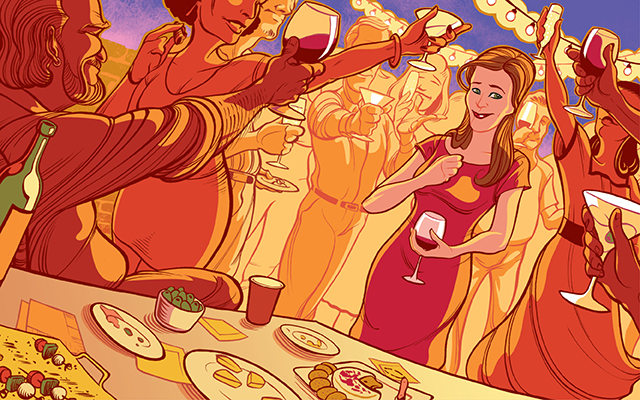Why don’t we party like they do in Spain’s Basque Country, with kids and grandparents and everyone making time for each other as part of daily life — not just during the holidays? That’s the main thought I came away with after a recent conversation with Alex Raij, America’s greatest Basque chef.
Raij is mainly known for her three popular New York City restaurants, which she runs with her husband and co-chef, Eder Montero. But when she’s not cooking, appearing on the Food Network, or chasing after her young children, she often thinks about Spain and wonders whether Americans would be happier if they took their kids to bars more often.
“Bars are wholesome places in Basque Country,” explains Raij, when I call her to talk about her excellent new cookbook, The Basque Book, which aims to bring some of this magic to American kitchens.
“In Basque Country, bars are not secretive places,” she says. “In Basque culture there’s a sense of life being anchored by these bars. They’re all clustered in places with no traffic, where kids can run free, and adults can, too. The result is that you could meet a friend on purpose or by accident any time of day, and have an adult conversation, while the children are cared for by other children and other adults.
“Everyone is engaged with children, and everyone is engaged with adults. It creates healthy adult relationships — and healthy kid relationships, too.
“It keeps you young, as well; you’re connected to the people of your youth, to children in the community, to all these multigenerational happenings and people.”
What else is so great about these bars?
In a word: pintxos. The Basque form of tapas, pintxos (pronounced PEEN-chos) are little snacks to enjoy with a glass of something, typically a beer, a local wine, dry sherry, or vermouth. In Basque cities, each bar offers only one or a few pintxos: perhaps oil-cured mushrooms, sliced sausage on bread, or skewers of olives, anchovies, and peppers. It’s not uncommon for families to sample the pintxos at one bar, then move on to another bar, and another after that. In the course of an evening, they see everyone they know, perhaps meet someone new, and reinforce all their community ties.
These pintxos — and Basque food generally — are delicious, which explains why this region is home to so many of the top European restaurants, including Mugaritz.
We are not all high-flying Basque chefs, of course, so it might seem like a tall order to add a little Basque flavor to our lives. But it’s not that difficult, says Raij. Just let simple outcomes be your lodestar.
“You don’t have to cook,” she says. “It’s enough to say, ‘I’ve got some olives, a can of amazing anchovies. Come over.’ Sharing an experience doesn’t mean you have to make a huge commitment to cooking all day.”
If you want to cook, Raij recommends a pintxo party centered around a few ingredients — ham, marinated vegetables, tomato pulp, and sliced bread, for example — for people to assemble their own tapas.
“People really like to be engaged with their food,” says Raij. “If they can smear and pile and layer and bite, that naturally leads to conversation.”
Many pintxos are designed to sit out for hours on a bar, so you can prepare them well ahead of your guests’ arrival. Sauté button mushrooms in olive oil with garlic and red-pepper flakes, then cook them down in vermouth. Once they’ve cooled, load them onto toothpicks or skewers to pair with cheese, bread, and martinis. (You can even throw one into a martini.)
Or you can make a little snack called a Gilda (after Rita Hayworth’s dancer in the 1946 movie Gilda) by loading up a skewer with an olive for a head, a long thin pickled pepper for arms, and more olives wrapped with anchovies for a body. A nutty, hard sheep’s-milk cheese (try manchego or P’tit Basque), roasted red peppers, and thinly sliced Spanish ham or salami round out a luxurious but easy-to-create Basque pintxo party.
If you’re thinking, This sounds impossibly out of my comfort zone, please know that Raij did not grow up swimming in Basque culture. In fact, she is the daughter of Argentinean expat Jews and was raised in Minneapolis. But when she finally discovered Basque food — and a Basque husband — she felt like she had found her true home.
It wasn’t because of the paprika, the onions, or any of the ingredients that define Basque food, she says. “It came from the Basque model of caring about the community, the pauses, the ease.
“People are more interested in the Basque story and Basque food than they ever have been,” says Raij. “I think part of it comes from the sense that you can put something in front of people that’s very simple, and, if the ingredients are right, that simplicity speaks more than something very complicated.
“People are grateful for these simple flavors today, more than they would have been a generation ago,” she adds. “Today, they feel you’re nurturing them. We’ve come full circle from a time when food was so overdone that flavors were masking flavors. And there’s this intimacy in Basque food that comes from the simplicity. You can’t really get that with another approach.”
Can you take some inspiration from the Basques and put together a party that makes room for adult conversation, kid freedom, multigenerational inclusiveness, and the undeniable simplicity of fat and briny olives? There’s no reason not to try.
Illustration by Paul Hostetler

This Post Has 0 Comments